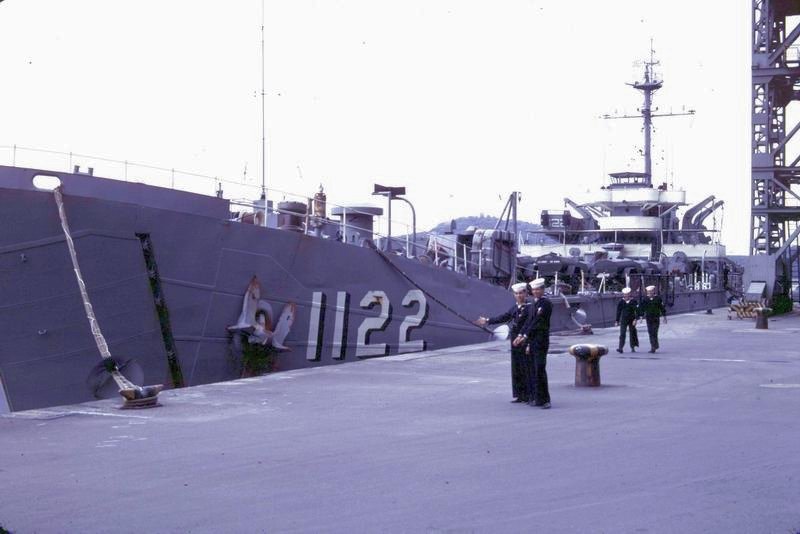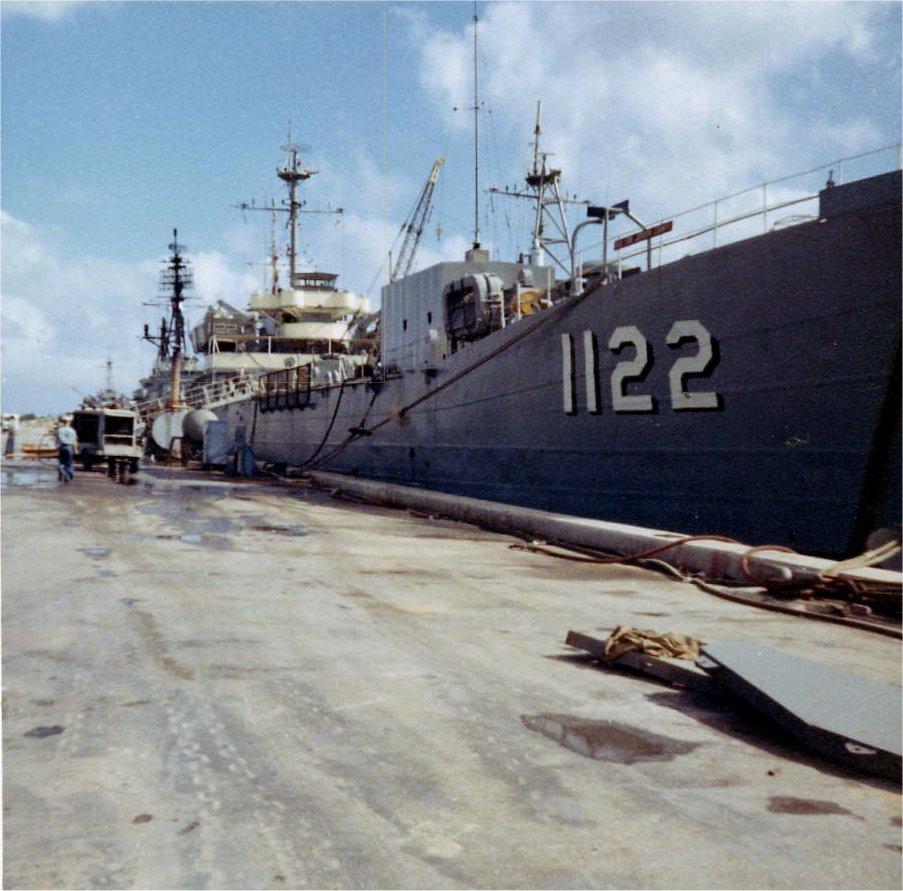|
Featured image: USS San Joaquin County (LST-1122)’s starboard propeller being removed/changed by divers from USS Ajax (AR-6) date and location unknown. US Navy photo.
First published by Global Research on June 19, 2020
A crucial element of Japan’s 1960 Treaty of Mutual Cooperation and Security with the United States, was that no nuclear weapons would be stationed within Japanese territory. Unknown to successive pro-American governments in Japan, along with the country’s population, was that this key provision was being violated in the most blatant fashion.
That same year, 1960, a mere couple of hundred yards off the coast of Iwakuni – a little known southern Japanese city – there was anchored an American flat-bottomed ship, the USS San Joaquin County. This seemingly innocuous vessel, at 328 feet long, was acting under the guise of an “electronics repair ship”, having first arrived at Iwakuni in September 1959.
In reality the San Joaquin County, which was afloat in Iwakuni’s tidal waters, was weighed down with nuclear weapons. The vessel, classified as an LST for “Landing Ship, Tank” or alternatively “tank landing ship”, was comfortably positioned within the three-mile limit of Japanese territorial waters. It was therefore stationed well inside the region of Japan, as even the most hawkish US official would have been forced to concede.
Had news of this massive breach of Japanese sovereignty leaked out, it would very likely have resulted in the demise of any American-friendly government in the country. Such a discovery may also have led to the US losing each of its precious military bases in Japan, along with a collapse of diplomatic relations between the states. Worst of all, a new Japanese administration could have shifted alliances toward Communist China and the USSR, in another blow to US hegemony in this key region.
Less than two decades earlier, two of Japan’s cities were leveled by US atomic bombs, some of the defining moments in human history. The attacks led to a nuclear domino effect, beginning with the USSR in 1949, and continuing with a further seven countries now possessing nuclear arsenals. The final death toll from the Hiroshima and Nagasaki bombings is estimated at over 200,000. The Japanese had not forgotten these callous attacks; hence the specific clause in the 1960 mutual security treaty, that no nuclear weapons be situated within Japan’s territory.

USS San Joaquin County (LST-1122) moored pierside Naval Station Yokosuka, Japan in 1968. Photo by Larry Roszkowiak
Meanwhile, far from having “station ship duties”, the real job description of the San Joaquin County was to deliver its nuclear arsenal to a handful of US bombers, permanently placed at Iwakuni for general war missions. During a nuclear emergency, the San Joaquin County would sail the 200 yards or so ashore, and lay down anchor. The front of the ship opened like a clamshell, whereby amphibious tractors emerged carrying the nuclear bombs; the vehicles rolled down a ramp and into the shallow water, or directly onto the beach. From there, the nuclear-laden tractors would travel to Iwakuni’s airstrip, loading the precious cargo onto the American planes.
A small Marine air base was located at Iwakuni, which had a covert understanding in which its bombers would receive their nuclear weapons after just minutes. They would in fact obtain their nuclear stockpiles six to 10 hours in advance of any other American bombers in Japan. However, in the event of any attacks on Communist states, the likelihood is the Iwakuni aircraft would have been held back. They may well have been ordered to wait until other US planes in Japan were armed with their own nuclear bombs, before flying off at a similar time. The contingencies at Iwakuni, to swiftly attack the USSR and China, would probably have been rendered meaningless in any case.
The nuclear situation at Iwakuni was not well known even among US Air Force and Navy planners. Yet it was common knowledge among personnel at the Iwakuni air base itself. This highly classified information could easily have been leaked, by accident or otherwise, to civilians such as the Japanese girlfriends of American crews at Iwakuni. What’s more, US planners had suspected this secret nuclear arsenal had already been discovered by Chinese or Russian spies – who would reveal their groundbreaking information at the most inopportune time. On some occasions, the San Joaquin County openly rehearsed its landing of the tractors with their cargo, in full view of the coastline.
In a separate instance, it would have been a routine operation for Communist frogmen (military scuba divers) to target the vulnerable “repair ship” with mines. Sabotage directed against the San Joaquin County could have resulted in a partial or full nuclear explosion, releasing huge amounts of radioactive material into the atmosphere. Iwakuni is only 26 miles from Hiroshima and, in such a case, that city may have experienced a second catastrophe within a generation.
Despite all the risks, the San Joaquin County remained at Iwakuni through periods of the Eisenhower, Kennedy and Johnson administrations. In July 1966, the San Joaquin County sailed to Guam for repairs; months following that in late November 1966, it relocated to Okinawa, a US-controlled island 1,200 km south of Iwakuni. Earlier that year the American ambassador to Japan, Edwin Reischauer, had learned of the ship’s presence at Iwakuni through a leak to his office. Reischauer threatened to resign unless it was moved clear of the Japanese mainland.

USS San Joaquin County (LST-1122) moored pierside at Naval Station Guam in 1968. Photo by Larry Roszkowiak
Gerald W. Johnson, the US special assistant to the secretary of defense for atomic weapons and energy, was responsible for knowing the precise location of every nuclear weapon in the world. However, Johnson was utterly unaware of the nuclear cargo hidden away in the San Joaquin County. Indeed, he was deliberately deceived, being led to believe the ship was present to conduct electronic overhauls – such deception ranking as an extremely serious offense.
Nor was Johnson aware of nuclear arsenals present in other American vessels, on or near, Japanese shorelines. US warships regularly arrived into Japanese ports for rest periods, which was vital for bolstering morale among travel-weary crew members. Also unknown to many in the Japanese government, along with the country’s general population, was that these ships were almost all loaded with nuclear weapons.
This further applied to the aircraft carriers that arrived into Japanese harbors – which carried nuclear bombs destined for American aircraft – and elsewhere, the large US destroyers, which were armed with masses of nuclear torpedoes. None of the American vessels ever bothered to deposit their nuclear arsenals to bases, before sailing into Japanese territorial waters.
These realities were supported by US Rear Admiral Eugene La Rocque, who said in 1974 that:
“My experience has been that any ship that is capable of carrying nuclear weapons carries nuclear weapons. They do not offload them when they go into foreign ports such as Japan, or other countries. If they are capable of carrying them, they normally keep them aboard ship at all times”.
This seems likely to be the case today.
The American vessels could be stationed at port for weeks on end, so virtually all year round there were nuclear weapons not far from Japanese civilian areas. Soviet Union war planners were undoubtedly aware these American ships were filled to the rafters with nuclear bombs – which in event of attack would be used against the USSR, the Chinese, or (most likely) both. As a result, Japan’s coastal regions constituted high priority targets for possible nuclear attacks directed from Moscow.
What’s more, with so many nuclear-armed craft sailing around in confined areas along Japan’s coasts, there was always a chance of an accidental collision, or other unforeseen incident. This could have led to a semi or full detonation of a nuclear bomb. The risk was small, but when multiplied by the presence of so many American ships straddled along the shorelines, it was hardly insignificant. The political opposition in Japan, along with anti-nuclear activists, would hardly have been impressed (had they known), nor would Emperor Hirohito one can guess.
When top level Japanese officials were asked if the US ships had nuclear bombs aboard, they spoke with baseless confidence that there were none. They would point to not having been notified by the Americans of the presence of such weapons. The US Department of Defense retains the same policy until today – they refuse to confirm or deny the presence, or absence, of nuclear weapons anywhere in the world.
*
Shane Quinn obtained an honors journalism degree. He is interested in writing primarily on foreign affairs, having been inspired by authors like Noam Chomsky. He is a frequent contributor to Global Research.
|